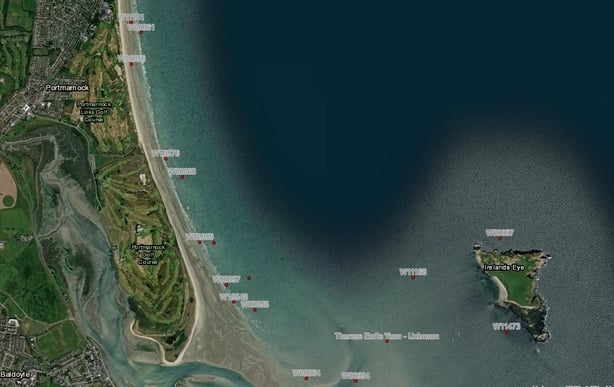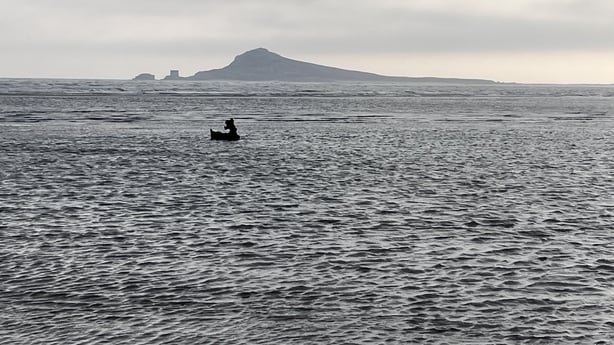It has been the talk of the town all week. Reports by RTÉ News on Monday that three new shipwrecks have been discovered on Portmarnock Strand prompted locals to comb the north Dublin beach, to see with their own eyes the pieces of the past that have up to now been hidden by the sands.
This stretch of the capitals coastline has quite the history of ships running ashore.
Some 50 wrecks are recorded in the Wreck Inventory, around the Portmarnock and Baldoyle areas which the National Monument Service says is “unusually high”.
The physical remains of at least 13 of these vessels have been located.
The documented wreckage’s range from 14th century trading ships to 20th century coal-boats and research suggests that most of the vessels recorded off Portmarnock Strand were lost during bad weather.
Several of the ships en-route to Dublin may have attempted to seek refuge in Howth Harbour during stormy conditions but failed to reach the safety of the harbour entrance and were compelled to run ashore on the strand to save lives.
Other ships, originating from ports on the west coast of Britain and bound for various global destinations, seem to have been driven ashore by stormy weather.
Below the National Monument Service outlines details about the three most recently uncovered wrecks, which provide some clues as to their origins and tell a story about maritime history around the north Dublin coast.
And they share with RTÉ News the stories of the other vessels whose journeys ended off this part of north Dublin’s coast.
Wreck #1
This 24.78m long wreck may be the Malfilatre, which came aground 125 years ago.
The 40-year-old, 116-tonne schooner of Bridgewater, Somerset, which was originally built in France, was en route from Cardiff to Dublin in December 1899 with a crew of four and a cargo of coal when it encountered severe gales and high seas that swept its decks and tore its sails.
Unable to reach its destination, the vessel went ashore at Portmarnock Point, opposite Ireland Eye.
The crew was forced to climb the rigging and spend the night there as waves swamped and filled the boat.
The severity of the seas made it too dangerous for the Coastguard to attempt a rescue by launching a lifeboat.
The following morning, Coastguard crews from Howth, Baldoyle, and Dun Laoghaire gathered on the beach. They rescued the crew by wading into the water and throwing lines to the ship.
The Malfilatre soon afterwards broke apart, becoming a total wreck, with its cargo washing ashore.
According to Lloyd’s Register, the official length and beam of the Malfilatre are recorded as 26.4m by 6.68m. The newly uncovered wreck located offshore of Portmarnock Point has a surviving length of 24.78m.
Due to the depth of the water, it was not possible to measure the width of the wreck. However, given the location of the wreck, its size, and general shape, it could well be a good match for that of the schooner Malfilatre.
Wreck #2
The second new wreck discovered is a wooden vessel comprising of the bow end of the vessel.
It is largely buried in the sands and measures 22.40m long x 6.35m in width.
While the hull is composed of wooden planks, the lodging knees, structural elements to support a deck, are formed from composite iron pieces and indicate the wreck most likely dates to the latter half of the 19th century or early 20th Century.

Wreck #3
The third wreck discovered is another wooden vessel, with only the stern end exposed.
The outline of the vessel is defined by a series of framing timbers and hull planking that are visible above the sand. Additionally, parts of the stern post and rudder can be seen.
The vessel measures 17.92m in length and 5.84m in width. The bow is either buried or has been washed away over time due to erosive action.
The National Monument Service believe this could be the Gainsborough.
This 25-year-old, 139-tonme brig of Ipswich, was en route from Liverpool under the command of Captain Daniel Jeffries.
It carried a valuable cargo worth £11,000. During its journey, it encountered a violent storm and was driven ashore at Portmarnock/Baldoyle Strand.
The crew, fearing they would be washed overboard, were forced to latch themselves to the rigging.
Despite the Coastguard’s several attempts to reach the stricken vessel and rescue the crew using a six-oared galley, the ferocity of the storm forced them back, with their boat filling with water at each attempt.
Once the weather moderated, they launched the boat again and succeeded in rescuing the survivors from the rigging. The survivors included the Master, two seamen, and one boy.
Unfortunately, three crew members lost their lives and the vessel was completely wrecked.
To commemorate the loss of the three crew members, a granite cross was erected at the top of Sea Road, Malahide.

Other notable shipwrecks off Portmarnock:
Nicholas
One of the earliest and most intriguing shipwrecks recorded in the Wreck Inventory took place in August 1306.
The Nicholas, a merchant ship from Co Down, was laden with a diverse cargo that included wine, chest with jewels, copper pots, wax, barrels of spices, tin, pitch, and steel.
During a severe storm, it was cast ashore on Portmarnock Strand, tragically resulting in the loss of some crew members.
While some of the crew and merchants survived the ordeal and made it to shore, the vessel quickly disintegrated, causing its valuable cargo to wash ashore.
The sight of such riches, seemingly gifted by the sea, proved irresistible to the local community.
This led to numerous charges of theft against individuals who succumbed to the temptation. Among those charged was a local man, John de Long of Malahide. He was accused of stealing three lamb’s furs, a green hood, and a barrel of valuable spices.
Additionally, he faced allegations of stealing and consuming some of the washed-up wine.
Lady Hobart
The Lady Hobart, a 781-tonne barque built in Nova Scotia in 1849, was en route from Liverpool to Bermuda with a cargo of coal.
There were 22 people on board, including Captain Louis Richmond and his crew.
On 29 January 1865, after heavy gales and fog, the vessel ran ashore on the sands near Baldoyle after 3am.
Although land had earlier been sighted on the port side, the Lady Hobart became embayed and was dragged ashore by the falling tide.
Nine crew members abandoned ship using the vessel’s lifeboat and landed on the beach in the first attempt.
The remaining men were precariously rescued on a second pass of the lifeboat, pulling through the surf after much difficulty.
Captain Richmond’s certificate was suspended for six months following the incident, as he was found to have neglected to wear the ship round when land was first sighted, in addition to failing to deploy the anchor in time.
The wreck of the Lady Hobart reportedly remained partially submerged on the sands, with the three masts standing proud.
In the weeks following, coal was noted to wash ashore during low tides, as well as pieces of timber and personal goods.
The Perseverance
The Perseverance was a 24-year-old 97-tonne schooner from Newry, en route from Ardrossan, Scotland with a cargo of coal.
On Friday 8 February 1861, a great storm swept along the eastern coast of the country, with severe gales encompassing all of Dublin Bay and beyond for two days.
The Perseverance was among many vessels in Dublin which suffered a calamitous fate that weekend, succumbing to the hazardous gales and conditions the following day.
The vessel is recorded as wrecking ashore at Baldoyle Strand.
The lives of four sailors from the Perseverance were lost to the storm, with two bodies reportedly washing ashore at Malahide in the following days. Only the ship’s master survived.
Eva
The Eva was a barque en route from Dublin to Ardrossan, Scotland with a cargo of ballast.
Eight crew members were on board the vessel, mastered by a J. Laurie.
After encountering difficulty and hazardous winds, the barque went ashore at Baldoyle Strand on Saturday 25 March 1877, and reportedly became a total wreck soon after.
The crew members, who had become lashed within the ship’s mizzen rigging, were rescued with great effort by a Howth lifeboat named the Clara Baker, which belonged to the RNLI (Royal National Lifeboat Institution).
The perilous conditions had further deteriorated to the extent that the lifeboat could not make the return to Howth, and instead had to go ashore at Baldoyle.
The Prosperity
The Prosperity, a 41-tonne smack from Caernarfon loaded with slates, was bound for Dundalk on 5 April 1907.
The vessel reportedly sprung a significant leak during a gale, resulting in water ingress of seven feet within the hold.
The vessel was subsequently lost when it ran ashore at the Baldoyle Strand.
A lifeboat from Howth rescued the three crew members on board.
British Queen
The British Queen was a schooner bound for Liverpool from Newfoundland.
The vessel was lost when it was driven ashore at Baldoyle on 16 November 1842, with a loss of four sailors on board.
Adelaide
The Adelaide, a schooner en route from Carlingford to Malahide with a cargo of coal, was lost at the sands of Baldoyle on 31 October 1871.
A heavy gale from the east had forced the vessel into a dangerous position, with heavy seas reportedly breaking over the nearby sandbank.
A lifeboat from Howth went out to aid the vessel during the severe conditions, and successfully rescued the crew with great difficulty.
